Reviews
Paul Leni
USA, 1928
Credits
Review by Ian Johnston
Posted on 20 February 2009
Source Kino DVD
Categories The Silence After Sound: Hollywood’s Last Silent Movies
The Man Who Laughs is the third of the four films that make up Paul Leni’s Hollywood career. Leni had made a big impact in Germany with his Expressionist Waxworks and the appeal of his first American film, The Cat and the Canary, lay in the Expressionist flourishes that he brought to enliven a rather banal stage play. The Man Who Laughs marked a move up in prestige and the size of production which at the same time, perhaps inevitably, rather tamed, though not completely, Leni’s cinematic imagination. (The intervening film, The Chinese Parrot, is, believe it or not, a now-lost Charlie Chan movie. Who knows what that looked like?) It’s clear that rather than German Expressionist films, the influences on The Man Who Laughs were the earlier big-budget successes of Hollywood silent cinema, The Hunchback of Notre Dame and The Phantom of the Opera. Both were Universal Studios productions from studio head Carl Laemmle, the man who lured Leni to Hollywood, and both starred Lon Chaney, the “Man of a Thousand Faces” who was famed for transforming himself into grotesque characters through special makeup effects. Hunchback’s Quasimodo and Phantom’s Erik were ideal roles for Chaney, as would have been Gwynplaine, The Man Who Laughs’ lead character whose face has had a permanent smile carved into it. Except that Chaney had left Universal for MGM.
Instead, the role went to Conrad Veidt, who had starred under Leni’s direction in Waxworks, and before that had been Cesare in The Cabinet of Dr Caligari; though probably Veidt’s most famous role - given how few people watch silent films - is as Major Strasser in Casablanca, the pursed-lipped Nazi that Rick/Bogart shoots down to audience cheers at the climax of the film. In The Man Who Laughs Veidt gives what is, to say the last, a committed performance. A device he wore on his mouth gave the effect of a permanently and grotesquely extended smile, which meant that Veidt had to rely on his eyes to express the range of emotions he goes through. Wearing this device must have been tiring if not painful and there are plenty of dramatically justified scenes where Gwynplaine conceals his smile under a handkerchief or a scarf, at the same time giving a Veidt a rest for his mouth.
Like The Hunchback of Notre Dame, The Man Who Laughs is an adaptation of a Victor Hugo novel. It shares with Hunchback the central narrative of a physically grotesque male in love with an innocent young woman and the theme of resistance to the cruelty of those in authority. Even if you haven’t read them, who hasn’t heard of The Hunchback of Notre Dame and Les Misérables? But I guess Hugo’s novel of The Man Who Laughs is as completely unknown to most people as it is to me. It seems pretty much to be a French fantasy of English history, not to be taken too seriously, with a frankly bizarre list of character names: Barkilphredo the jester, Lord Clancharlie, Dr Hardquanonne, the Duchess Josiana, Lord Dirry-Moir, and so forth, a Frenchman’s idea of late eighteenth century English names. Not that Hollywood has ever been worried by historical verisimilitude, and in the case of The Man Who Laughs Laemmle’s Universal enthusiastically threw all its big-budget resources at this recreation of Old World cruelty and decadence.
At the start of the story Gwynplaine is the young son of rebel aristocrat Lord Clancharlie who is tortured to death under the orders of James II. The son is sold to roving gypsies called “comprachicos” who specialise in turning young children into freak-show attractions by carving a permanent grin on their faces. This is what happens to Gwynplaine but, when the comprachicos are later banished from England, he is left behind, abandoned in the winter snows. This is a great early scene, in this large set of snow, wind, and darkness, a broad barren snowy landscape with bodies swinging in the background as they hang from gibbets. It gives perfect expression to Gwynplaine’s feelings of isolation, abandonment, and misery.
Still, Gwynplaine is rescued here, along with the blind baby girl he finds in the snow, by the travelling showman Ursus the Philosopher, and then the story jumps years to find the adult Gwynplaine now a popular fairground attraction, “The Laughing Man”, and the blind girl his beloved fiancée Dea, both looked after by their surrogate father Ursus. Dea herself is the ultimate silent heroine, golden-haired, dressed in virginal white, and on occasion bathed by Leni in shafts of angelic light.
But Gwynplaine is in fact anything but happy or contented with his professional success and loving relationship, his inner anguish mocked by the permanent smile on his face. He’s perfectly aware that his success with the fairground punters is based on their superior laughter at him, as is made very apparent in the scene when they intrude cruelly on an intimate scene between him and Dea. And Gwynplaine’s sense of his own physical deformity makes him feel unworthy of Dea’s love - he has never allowed Dea to touch his mouth - as well as unsure that she could love him for his true self.
Gwynplaine’s self-worth is finally validated when he’s made the object of explicit sexual pursuit by the Duchess Josiana. She’s a fascinating character that really kicks this film into life. Played by Russian actress Olga Baclanova (best-known now for her role as the trapeze artist who comes to a nasty but still alive end in Tod Browning’s Freaks) she’s a woman consumed by her erotic drives. She’s viewed in erotic terms by the film too: when she disrobes and plunges into a pool, the camera drops to pick up the reflection of her body in the water; she’s glimpsed naked through a keyhole; and she’s seen abandoning the staid court to cavort with some rough trade at the Southwark Fair.
Josiana is transfixed by Gwynplaine’s performance as The Laughing Man, staring with heaving bosom as his mouth is revealed, her eyes locking on his over the heads of the audience that stands between the stage and her box. The mouth has a profound and perverse erotic appeal for her, repeated when Gwynplaine is invited to her mansion and she stretches out provocatively on the bed in front of him. In this scene Josiana is clearly sexually aroused by the sight of his smiling mouth.
Significantly, Leni cuts straightaway to a shot of a praying Dea, an appeal to Gwynplaine’s conscience and a repudiation of Josiana. In any case Josiana quickly rejects Gwynplaine himself as she is caught up in a complex plot of revenge hatched by Barkilphedro and Queen Anne to force Josiana to marry Gwynplaine. The mansion that Josiana resides in is in fact Gwynplaine’s rightful inheritance as the son of Lord Clancharlie, and the pace of events now pick up as Gwynplaine is spirited away to prison, presumed dead, released, and then inducted into the House of Lords.
The lines that separate class, between the aristocrats of the court and the show people at Southwark Fair, are firmly drawn, and they are lines that reflect a moral judgment on the former. This is reinforced in the visual contrasts between fair and court, between on the one hand the tumultuous crowd packed together and filling up the frame, and on the other the bored spectators and solemn ceremonies, the figures dwarfed by the empty space of the huge rooms.
When Gwynplaine makes his appearance in the House of Lords, this upper class proves even crueller than the fairgoers at the sight of the ever-smiling mouth. Veidt plays the scene with moving pathos as the camera first focuses on the top of his head, the wig and the eyes filling with tears, before it drops to Gywnplaine’s smiling mouth and observes the handkerchief raised to cover his eyes, the mark of his shame and humiliation.
But this is also the moment when Gwynplaine asserts his humanity in a speech that Hugo surely (given the French Romantics’ enthusiasm for Shakespeare) modelled on Shylock’s “Hath not a Jew eyes?”—“A King made me a clown - A Queen made me Lord - But first, God made me a man!” (A precursor, too, of The Elephant Man’s “I am not an animal, I am a human being!”) Leni invests Gwynplaine with great nobility here, shooting low-angle to give him stature as he stretches out his arms in protest.
And protest is what the rest of the film does too. Gwynplaine rejects the aristocratic world to return to his “people”, who welcome him with open arms. The film then climaxes in a big-budget extravaganza with sudden escapes, a mass of ordinary people arrayed against the pursuing soldiers, a duel on a rooftop, a leap from one roof to another, a dramatic moment when Gwynplaine hangs precariously by his finger-tips from an overhead beam—all of which Leni stages with great gusto and energy. But where his heart lies is when the crowds are left behind, evil enemies are defeated, and the focus is reduced to this family of Ursus, Gwynplaine, and Dea, as they turn their backs on this corrupt world and sail off to a better one.
More The Silence After Sound: Hollywood’s Last Silent Movies
-
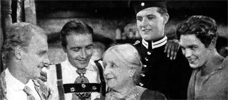
Four Sons
1928 -
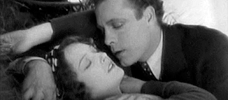
The Crowd
1928 -
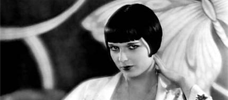
A Girl in Every Port
1928 -
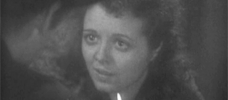
Street Angel
1928 -
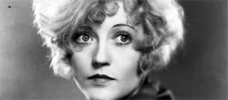
The Patsy
1928 -
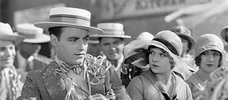
Lonesome
1928 -
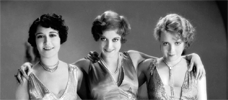
Our Dancing Daughters
1928 -
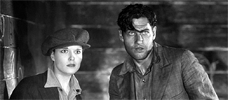
Beggars of Life
1928 -
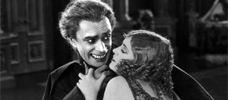
The Man Who Laughs
1928 -
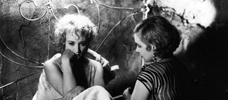
The Docks of New York
1928 -
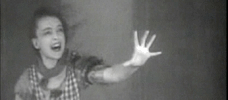
The Wind
1928 -
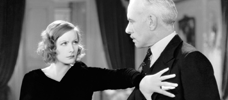
A Woman of Affairs
1928 -
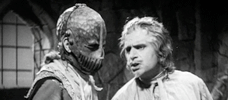
Iron Mask
1929 -
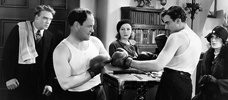
The Single Standard
1929 -
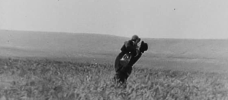
City Girl
1930 -
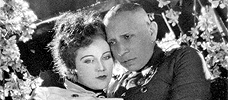
The Wedding March
1928
We don’t do comments anymore, but you may contact us here or find us on Twitter or Facebook.



